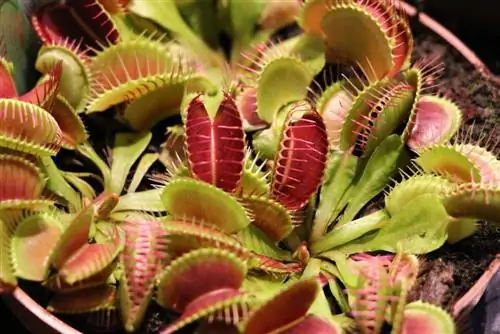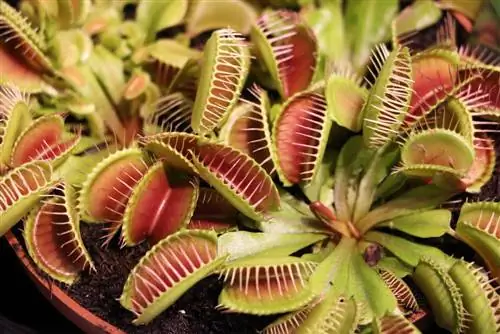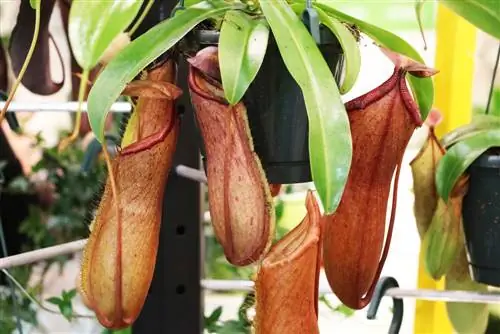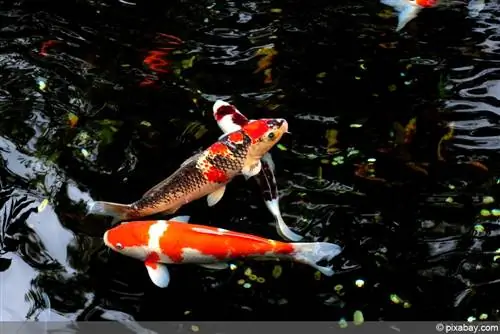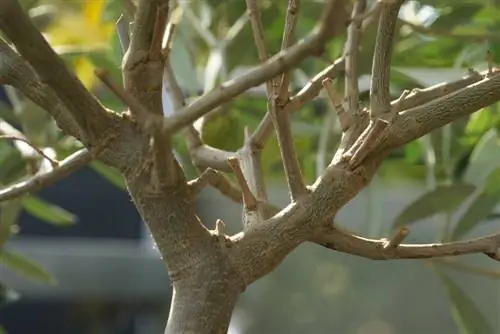- Author admin [email protected].
- Public 2023-12-17 03:39.
- Last modified 2025-01-24 12:45.
Like a Venus, it dresses in red, exudes an attractive scent and spreads its leafy arms. All insects are welcome there. And then it lives up to the second part of the name. The trap snaps shut, the fly is at its mercy and is consumed along with its wings. Would you also like to experience this drama up close? But what backdrop does this diva need?
Origin
The Venus flytrap, bot. Dionaea muscipula, is originally a southern beauty from North and South Carolina. It thrives wild in barren swamps. Because of the insect's fascinating appetite, it is now allowed to demonstrate its hunting skills in living rooms all over the world.
Growth and catching mechanism
The Venus flytrap is small and grows slowly and herbaceously. It only blooms after several years. In spring, a stem about 30 cm long grows on which several white flowers develop. But they don't attract their prey with the scent of the flowers. Their approximately 4 cm long leaves look like traps and that's how they work. As soon as they feel contact on their surface, they snap shut in a fraction of a second. The red color of the leaf surface and a sophisticated mixture of scents attract the victim. It is slowly digested over days until there is hardly anything left of it. Each catch leaf can only trigger this catch mechanism a few times. But new traps are constantly emerging.
Location
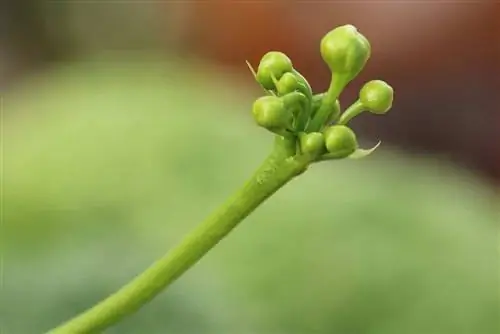
A lot of light and sun are essential for the Venus flytrap. Only when she gets enough of it does her fang leaves turn red. The red color simulates a flower and thus attracts the nutrient-rich insects. In partial shade the plant would grow, but its leaves would remain green. The ideal location has the following characteristics:
- very sunny
- flooded with light
- South window is ideal
- with humidity over 50%
- no drafts
- Temperature from 22 degrees Celsius
- no high temperature fluctuations
The Venus flytrap is welcome to spend a long summer vacation outdoors. It tolerates the fresh air and the blazing sun excellently. However, it must first be gradually accustomed to the new location. It can also be planted out in milder areas. The terrarium offers a good living environment for the Venus flytrap. She thanks anyone who can make this possible for her with good development.
Substrate
Ordinary potting soil and the native soil of these carnivores don't have much in common. Therefore, spare the Venus flytrap from this standard mixture and give it a special, lime-free substrate from a specialist retailer. Alternatively, you can also make your own mixture of peat and sand. Fertilizer, humus and other nutrients must not get lost in it.
Pouring
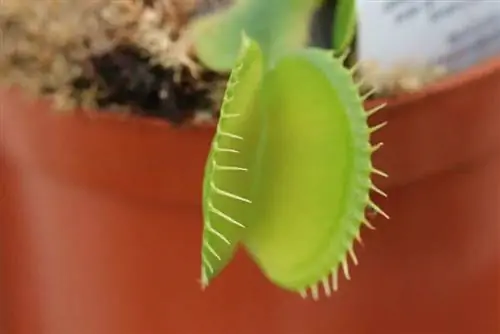
As a hunter of the swamps, the Venus flytrap naturally has to have its roots in the wet ground as a houseplant. Since the potting soil in closed walls is not kept moist by nature, the owner has to regularly bring water. This task is definitely a challenge because the Venus flytrap can react like a mimosa if mistakes are made. You definitely shouldn't do this:
- give her hard water, it will kill her in no time
- water from above as there is a risk of rot
- let the earth dry out
Stick to the following rules when watering:
- the substrate should always be moist
- Rainwater is ideal
- alternatively use decalcified water
- pour directly into the coaster
- In summer there should always be water in the saucer, approx. 2 cm
- In winter the substrate should only be moderately moist
- In winter it is enough to water once a month
Humidity
It's not just your feet that want to be wet, the leaves also like to stick out in moist air. According to experts, this should be at least 50% high. Except on rainy days, the Venus flytrap will not encounter such high humidity in our climate unless its owner takes pity and helps.
- Indoor fountains ensure a better indoor climate
- Place glass bowls with water nearby
- Cultivation in glass containers
- Hang the humidifier on the heater
- spray with water in summer, but without lime!
Tip:
Humidity meters can be bought cheaply, so you don't have to estimate the humidity by feel, but rather play it safe.
Fertilize
The Venus flytrap is originally used to poor soils. And because their roots find hardly any nutrients in the soil, evolution has found a solution with a lot of ingenuity. The Venus flytrap gets the nutrients it needs from the air by attracting and digesting nearby flying insects. Since she is a so-called weak eater, these nutrients of animal origin are sufficient for her. It does not need to be additionally fertilized.
Feeding
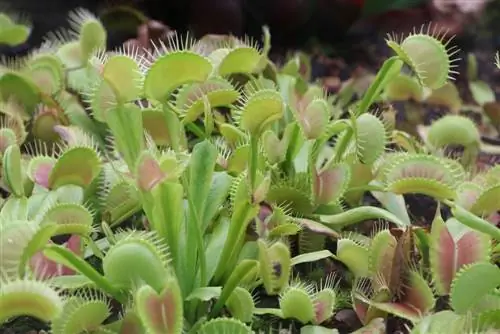
A question that is atypical for plants really comes to mind when it comes to this strange plant. Does the Venus flytrap need to be fed? And if so, with what? What is her favorite food? Does she need variety on the menu? Before any further questions arise in this regard, it should be made clear: The Venus flytrap is absolutely capable of taking sufficient prey and thus taking care of itself.
The green hunter can snap her blades shut in a split second when hunting insects. This is a fascinating display and one of the main reasons this carnivore is kept. Unfortunately, no one can wait next to her around the clock so as not to miss this moment. Extra feeding is therefore tempting for every owner. There is nothing wrong with that if you observe the following.
- feed them occasionally and not regularly
- only with live animals
- Prey no larger than a third of the blade
- feed spiders, flies, beetles, wasps or ants
Note:
Dead animals are not digested because the movement of the animals is missing as a trigger for digestion. The mechanism of the tentacles becomes exhausted after a few attempts at catching, so new leaves have to be formed. Don't waste the Venus flytrap's energy pointlessly!
Cutting flowers
The formation of flowers binds a lot of energy. If you don't particularly care, you can cut off the flower stems as soon as they appear. Then more energy remains for the formation of the trap leaves, which are much more interesting for most people anyway. However, if you want to propagate Venus Flytrap from seeds, you will need to leave a few flowers for the seeds to mature.
Propagation by cuttings
Do you need more beautiful fly catchers? No problem, propagation through leaf cuttings is easy and the chances of success are excellent.
- Choose a he althy, strong leaf.
- Cut the leaf close to the base with a sharp, clean knife. There should be a few roots.
- Fill a pot with suitable substrate.
- Wet the substrate well.
- Insert the leaf cutting into the substrate.
- Keep the substrate moist.
You still have to be patient until a new plant develops. Because it takes months to get to that point.
Reproduction by division

Repotting after the winter break is a good opportunity to raise offspring.
- Get the Venus flytrap out of the pot.
- Free the root ball from the substrate.
- Divide the rhizome with a sharp and clean knife. Roots and leaves should remain on each section.
- Plant the new sections in separate pots.
- Keep the substrate well moist so that the roots grow quickly.
Until the roots have developed well, the young Venus flytrap should be protected from excessive sunlight.
Propagation by seeds
In view of the well-functioning propagation from cuttings and propagation by division, the last propagation variant is more for those who like to experiment and have an extra supply of patience. Many years can pass before the Venus flytrap hatched from seeds blooms and catches flies. The seeds are cold germinators, which requires a long sowing process.
- Place the seeds in a closed container that protects the seeds from mold.
- Place the container with seeds in the refrigerator for about a month.
- Choose a shallow pot that has holes evenly perforated at the bottom.
- Add peat and sand and place the pot in a bowl filled with water.
- When the mixture is saturated, allow the excess water to drain off.
- Spread the seeds on the substrate, a few centimeters apart. Do not cover the seeds!
- Put cling film over the pot and poke a few holes in it.
- Place the pot in a bright place.
- The first seedlings will appear in about 2-4 weeks. Now remove the foil.
- If the plants are too crowded, give each one its own pot.
Tip:
Crush the large pieces of peat so that they do not form insurmountable obstacles for the still tender roots.
Repotting
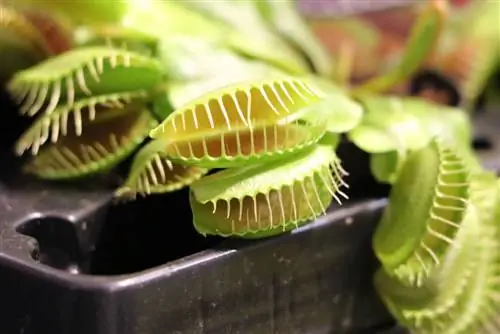
It takes about a year for the Venus flytrap to fill its pot with roots and begin to grow over the edge. It's then time to give her a new pot.
- Pot can be flat as the roots grow flat
- use suitable substrate
- ideal time is February/March after winter rest
- immediately before moving to a warmer location
- dead root parts must be removed
- use a clean knife or scissors
- don't bury the bale too deep
- pour well
Wintering
The Venus flytrap needs a break in winter. In time for autumn it makes its need for rest clear by forming smaller leaves. The trap leaves also no longer open and do not turn red. Find suitable accommodation for them now. It should be very bright, with temperatures of 5 to 10 degrees. Drafts and strong temperature fluctuations should be avoided as much as possible. Unheated stairwells, bright attics or basement rooms with daylight can be considered.
The rest break reduces the care effort to a minimum:
- no fertilizer or feed
- little water, only about 1-2 times a month
- no waterlogging
Note:
Young plants do not hibernate and should therefore remain in their usual, warm place in winter.
Wintering in the refrigerator
A somewhat strange solution to a lack of winter quarters is your own refrigerator. But don't worry, the Venus trap can handle it and your food won't be damaged either. Due to the tightness in the refrigerator, the Venus flytrap can move in there without the pot and without the substrate.
- Remove the plant completely from the substrate
- Cut off all parts growing above ground.
- Rinse the root ball with lukewarm water.
- Wrap the root ball with several damp layers of kitchen paper.
- Put this “package” in a transparent bag and seal it tightly.
- Keep the bag in the fridge until April.
- Remove any rotten roots.
- Replant the Venus flytrap.
Tip:
Slowly get the plant used to the full sun again.
Overwintering outdoors
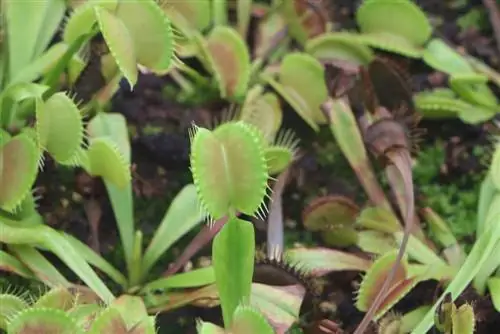
The Venus flytrap is partially hardy and could survive the winter outside in milder areas. The emphasis is on “could”. There can be no security, so this wintering option needs to be carefully considered. Older, well-developed specimens have the greatest chance of survival. But they also need a protected place and additional cover.
Diseases and pests
If cared for well, the Venus flytrap is not very susceptible to disease. In rare cases, they face some challenges. If the air in the winter quarters is dry and warm, the Venus flytrap can be attacked byspider mites. Webs are visible on the underside of the leaf, while the upper side has silver-colored dots. The humidity should be increased, that helps.
Aphid infestation follows little light, i.e. usually in the winter when growth is weak. Check your carnivores regularly for aphids. They are easy to rinse off, which is usually enough as a first step.
Grey coating that looks like mold is the so-calledGray mold. Remove all infected plant parts. If that's not enough, you may need to use a fungicide or give up the plant.
Tip:
If the Venus flytrap's vitality has suffered, its natural defenses can be rebuilt with a plant tonic.

